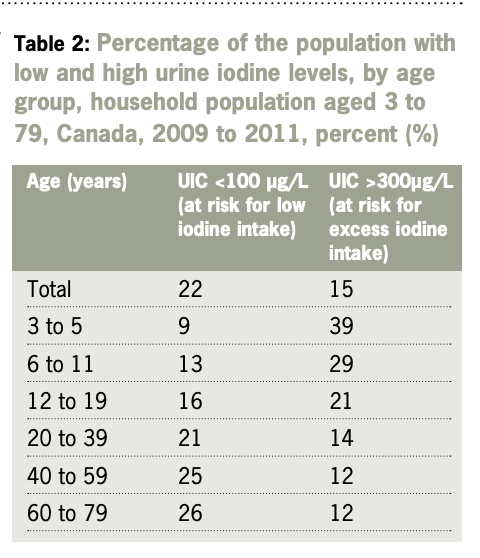NOTE: So far (2022) - none (!) of the ELEMENT studies conducted on fluoride/IQ/Adverse Birth Events have investigated the iodine intake in the pregnant women or their offspring. ELEMENT studies were done in Mexico City.
Maternity/Offspring IQ fluoride studies everywhere fail to account for iodine intake and thyroid status in the children at the age/time of the actual investigation.
Gonzalez-Nunez A, García-Solís P, Ramirez-Garcia SG, Flores-Ramirez G, Vela-Amieva M, Lara-Díaz VJ, Rojas-Martínez A - "High Iodine Urinary Concentration Is Associated with High TSH Levels but Not with Nutrition Status in Schoolchildren of Northeastern Mexico" Nutrients 13(11):3975 (2021)
https://www.ncbi.nlm.nih.gov/pmc/articles/PMC8624725/
"According to the Iodine Global Network, Mexico is considered a country with adequate national iodine intake (297 mg/L), but some regions have not been studied. We aimed to evaluate urinary iodine concentration (UIC) and its association with thyroid stimulating hormone (TSH) levels and the nutritional status in 307 children (aged 5 to 11 years) from three elementary schools of Monterrey, northern Mexico. UIC in spot urine samples and capillary TSH levels were measured to assess thyroid function, in addition to weight, height, body mass index (BMI), and waist circumference (WC). We found a median UIC of 442 mg/L and a significant association between UIC and TSH levels by logistic regression when data were adjusted for (1) age and sex; (2) age, sex, and WC; and (3) age, sex, and weight status. UIC values were higher in 7-year-old children compared to 11-year-old children. High prevalences of overweight/obesity (41%) and WC >90 pctl (22%) were observed. This study identified higher UIC levels in children than those previously reported in the country. The UIC showed a positive and significant correlation between TSH levels in the three models evaluated. More studies are needed to assess the causes and possible outcomes of high UIC levels."
------------------------------------------------------------------------------------------------------------
Galván M, Fernández Cortés TL, Suárez-Diéguez T, López-Rodríguez G p- "Iodine nutritional status in urban and rural Mexican schoolchildren" Endocrinol Diabetes Nutr (Engl Ed) 67(4):228-234 (2020). English, Spanish. doi: 10.1016/j.endinu.2019.09.003
https://pubmed.ncbi.nlm.nih.gov/31791897/
"Median urinary iodine level was 278.4μg/L (177.3-360.9, IQR), 13.2% of children assessed had iodine levels <100μg/L, and 41.8% had values ≥300μg/L. Indigenous schoolchildren had the greatest risk of urinary iodine levels <100μg/L (β = 2.29, CI 1.1-4.6, p <.05), while children from urban and non-indigenous localities had a high risk of iodine levels >300μg/L (β = 2.2, CI 1.3 -3.9, p <.01, and β = 3.8, CI 2.2-6.5, p <.01 respectively). Median iodine level in salt was 35.9ppm (29.1-42.4 IQR), and there were no differences in iodine levels in salt by type of location or ethnicity.
There was high prevalence of urinary iodine levels ≥300μg/L in schoolchildren living in urban areas which was associated to high sodium intake from processed food."
-----------------------------------------------------------------------------------------------------------
Mexican Adults (Mexico City)
Flores-Rebollar A, Lendechy Velázquez M, Castro Sánchez A, López Carrasco G, Ruiz Juvera A - "Urinary iodine excretion in healthy Mexican adults" Arch Latinoam Nutr. 64(3):153-60 (2014) -> Mexico City
https://www.alanrevista.org/ediciones/2014/3/art-2/
"Excessive dietary iodine intake was established in 31.4% of all volunteers according to their UI, placing them at risk of thyroid dysfunction."
Fifty-seven percent of the volunteers had above-optimal intake.
-----------------------------------------------------------------------------------------------------------
Flores-Rebollar A, Moreno-Castañeda L, Vega-Servín NS, López-Carrasco G, Ruiz-Juvera A - "Prevalence of autoimmune thyroiditis and thyroid dysfunction in healthy adult Mexicans with a slightly excessive iodine intake" Nutr Hosp 32(2):918-24 (2015). doi: 10.3305/nh.2015.32.2.9246
http://www.aulamedica.es/nh/pdf/9246.pdf
https://web.archive.org/web/20230321114 ... f/9246.pdf
"Median UI was 267 μg/L, (IQR 161.3 - 482.5)....in spite of our study's limitations, the frequency of autoimmune thyroiditis is clearly elevated in the studied population. Further studies are necessary in order to define the prevalence of autoimmune thyroid disease as well as the current iodine nutritional status in our country."
Same study - Info on South America
"In Latin America, the situation appears to be different since there are several reports reflecting a tendency toward excessive dietary iodine intake since the publication of ThyroMobil in 2004. Chile, Ecuador and Brazil were reported to have a median UI > 300 µg/L, although Chile was an exceptional case since 100% of individuals had a UI > 300 µg/L (median 540 µg/L). Venezuela, Paraguay, Honduras and Peru had UI levels between 200 and 299 µg/L, reflecting a more than adequate dietary iodine intake. Of the 13 countries studied, more than half had an excessive iodine intake (29). The ICCIDD regional coordinator’s for Latin America last report showed that after studying 22 countries, 13 had a median UI > 200 µg/L but in 8 countries, a national survey had not been conducted within the previous 8 years and among these, was Mexico (30). Other non-nationwide studies conducted in the region have shown the same tendency, including Colombia (31), Brazil (6) and Peru (32). This predisposition to excessive iodine intake in our region may possibly increase the rates of autoimmune thyroiditis and hypothyroidism in our populations; although there are few studies investigating the prevalence of these problems in the region, it seems this is occurring, as suggested by publications from Brazil (6,7,14,19) and Chile (33)."
SEE also:
García-Solís P, Solís-S JC, García-Gaytán AC, Reyes-Mendoza VA, Robles-Osorio L, Hernández-Montiel HL, Leo-Amador GE - "Iodine nutrition status in pregnant women in Mexico" Thyroid 21(12):1367-71 (2011). doi: 10.1089/thy.2011.0197
https://www.liebertpub.com/doi/10.1089/thy.2011.0197
"The median of UIC was 273, 285, and 231 μg/L in the first, second, and third trimesters of gestation, respectively. Globally, the median (range) of UIC was 260 (5–1320) μg/L, and the percentage of samples with UIC below 150 μg/L was 28%."

